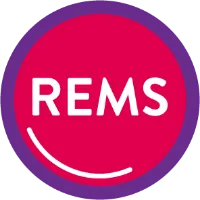Resources for prescribers
Resources for healthcare providers (HCPs) who are ready to prescribe FINTEPLA
The following resources can be used to provide you and your office with key information on prescribing FINTEPLA.
Are you looking for resources to share with your patients’ caregivers?
Dosing FINTEPLA
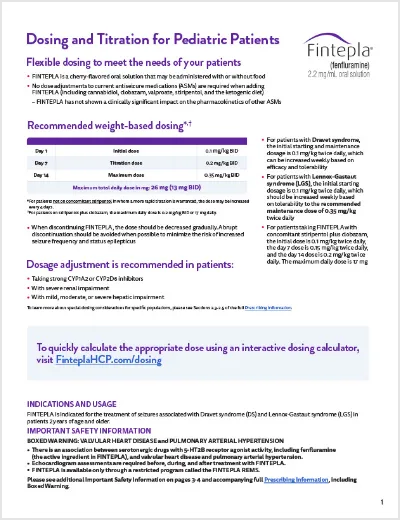
FINTEPLA Dosing and Titration Flashcard
Provides prescribers with the recommended starting doses and titration schedules for FINTEPLA
About echocardiograms
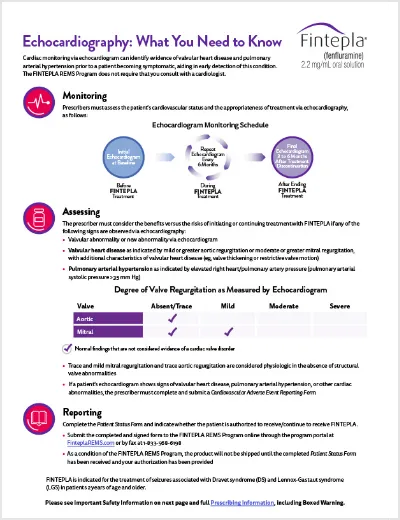
Echocardiography: What You Need to Know
Provides prescribers with an overview of the REMS-required monitoring with echocardiograms for patients taking FINTEPLA
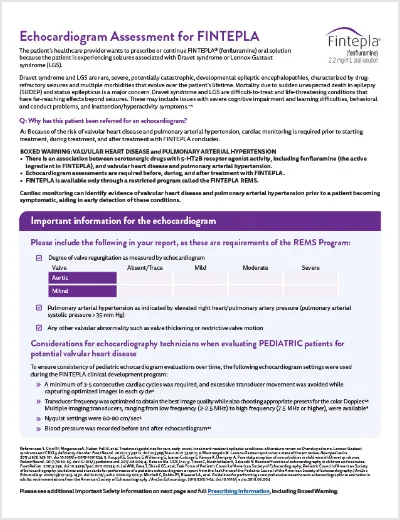
Echocardiogram Assessment Sheet
Provides cardiologists and echocardiography technicians with information on monitoring for FINTEPLA patients
ONWARD® is here for you and your staff.
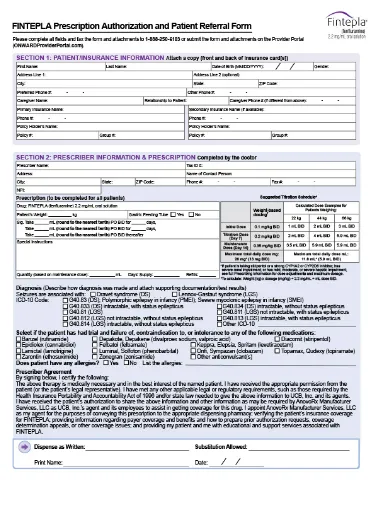
Patient Authorization and Patient Referral Form
By completing and submitting this form, you can provide the first prescription and enroll the patient in ONWARD
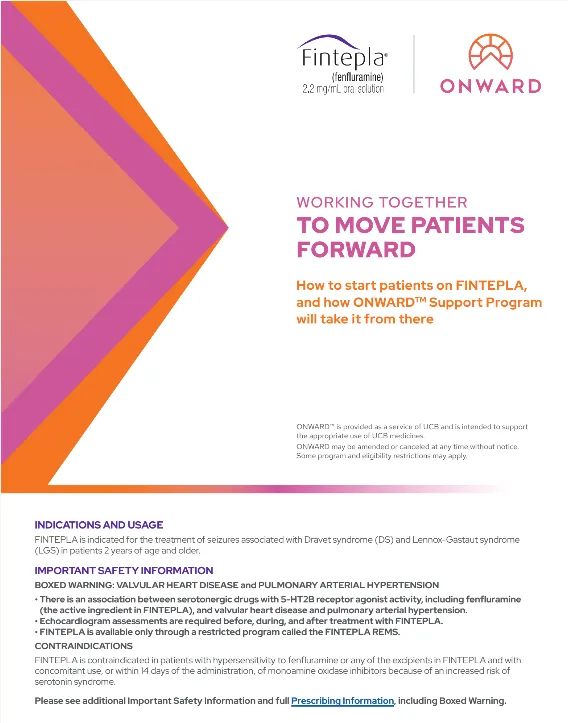
Prescribing FINTEPLA
Provides prescribers with an overview of getting patients started on FINTEPLA
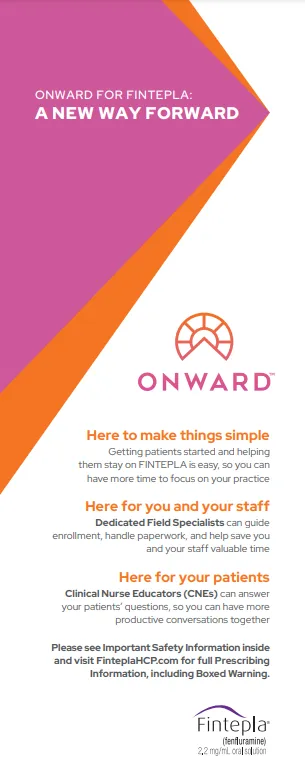
ONWARD Backgrounder for Prescribers
Provides prescribers with a brief overview of how ONWARD can guide their staff and caregivers
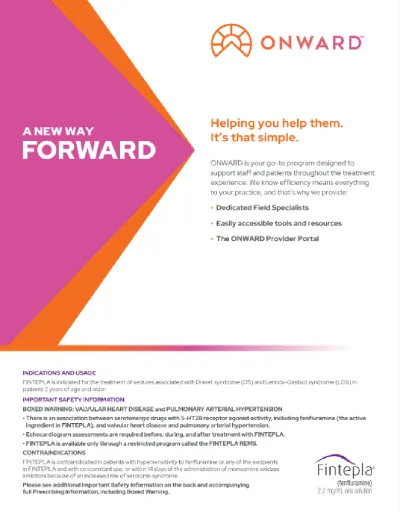
ONWARD Backgrounder for Office Staff
Provides details on support for the office staff, including dedicated Field Specialists, accessible resources, and the ONWARD Provider Portal
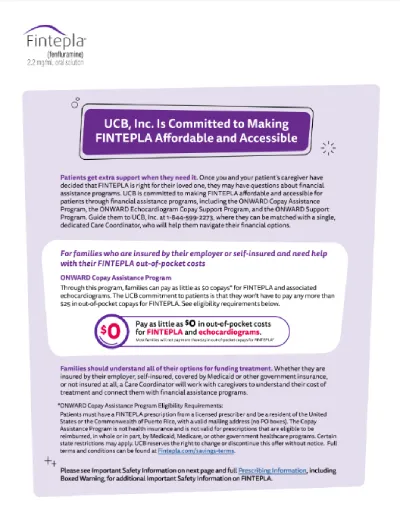
Financial Assistance and Copay Info for HCPs
Provides an overview of the financial assistance programs available for FINTEPLA and associated echocardiograms
Learn from your peers who have experience treating patients with FINTEPLA.
James Wheless, MD
Shares Dravet syndrome clinical trial data and a patient case from his practice
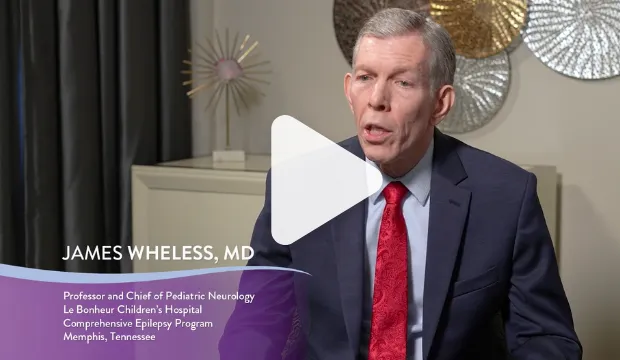
Steven Wolf, MD
Shares information about the impact of Dravet syndrome and critical considerations for optimizing seizure treatment

James Wheless, MD
Shares cardiovascular safety data and his clinical experience treating patients with FINTEPLA

Steven Wolf, MD
Shares best practices regarding cardiovascular monitoring for patients taking FINTEPLA

Scott Perry, MD, and Kelly Knupp, MD
Discuss challenges in treating Dravet syndrome
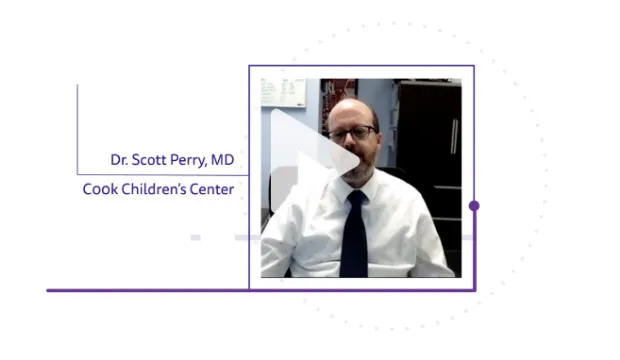
Important contact information
Frequently asked questions1
FINTEPLA is indicated for the treatment of seizures associated with Dravet syndrome and Lennox-Gastaut syndrome (LGS) in patients 2 years of age and older.
In the randomized, double-blind, placebo-controlled trials of FINTEPLA in Dravet syndrome, convulsive seizure types assessed included tonic, clonic, generalized tonic-clonic (GTC), tonic-atonic, secondarily GTC, hemiclonic, and focal with observable motor signs.
In the randomized, double-blind, placebo-controlled trial of FINTEPLA in LGS, the primary endpoint was the change in frequency of the following seizure types that were confirmed by The Epilepsy Study Consortium to have resulted in a drop, fall, or injury: generalized tonic-clonic (GTC), secondarily GTC, tonic, atonic, and tonic-atonic.
Patients on a ketogenic diet were included in the clinical studies. FINTEPLA is compatible with a ketogenic diet and contains no ingredient made from gluten-containing grain (wheat, barley, or rye) and not more than 0.1% of carbohydrates, which is solely derived from the cherry flavor.
Most patients do not need to have a cardiology consultation in order to get an echocardiogram, which can be ordered as a screening test, just like other screening procedures. However, certain epilepsy centers require that an epileptologist refer a patient to a cardiologist in order to get an echocardiogram.
UCB is committed to making FINTEPLA affordable and accessible for patients through financial assistance programs. Patients may pay as little as $0 in out-of-pocket costs for FINTEPLA and echocardiograms. Most families will not pay more than $25 in out-of-pocket copays for FINTEPLA.* For more information about these financial assistance programs, including eligibility criteria, call 1-833-GO-DS-LGS (1-833-463-7547).
*Subject to eligibility; individual out-of-pocket costs may vary. See full Terms and Conditions.
UCB strives to make the FINTEPLA Risk Evaluation and Mitigation Strategy (REMS) as accessible as possible. That’s why UCB has established a network of sonographers who can travel directly to eligible patients who are unable to access an echocardiogram (echo) facility due to their geographic location or disease-related limitations. Full eligibility Terms and Conditions apply.*
*Eligibility Terms and Conditions: The At-home Echo Program is intended to assist certain eligible patients who have been prescribed FINTEPLA to obtain an echocardiogram assessment in accordance with the product labeling and the FINTEPLA REMS, as required by the US Food and Drug Administration. To be eligible for the program, a patient (or their caregiver) must attest that they are unable to safely access a qualified healthcare provider’s office for an echocardiogram due to their geographic location or disease-related limitations. Participating patients, caregivers, and/or healthcare providers may not submit any claims for reimbursement to any third-party payer for echocardiograms provided through the program. The program may be amended or canceled at any time without notice.
Reference
1. FINTEPLA (fenfluramine) oral solution: U.S. prescribing information. Smyrna, GA: UCB, Inc.
Important Safety Information
See moreBOXED WARNING: VALVULAR HEART DISEASE and PULMONARY ARTERIAL HYPERTENSION
- FINTEPLA can cause valvular heart disease and pulmonary arterial hypertension.
- Echocardiogram assessments are required before, during, and after treatment with FINTEPLA.
- FINTEPLA is available only through a restricted program called the FINTEPLA REMS.
CONTRAINDICATIONS
FINTEPLA is contraindicated in patients with hypersensitivity to fenfluramine or any of the excipients in FINTEPLA and with concomitant use, or within 14 days of the administration, of monoamine oxidase inhibitors because of an increased risk of serotonin syndrome.
WARNINGS AND PRECAUTIONS
Valvular Heart Disease and Pulmonary Arterial Hypertension (see Boxed Warning): FINTEPLA can cause valvular heart disease (VHD) and pulmonary arterial hypertension (PAH). Although no patients receiving FINTEPLA developed VHD or PAH in clinical trials for DS and LGS of up to 3 years in duration, cases of VHD and PAH have been reported during use of FINTEPLA in the postmarketing setting. Because of this risk, cardiac monitoring is required prior to starting treatment, during treatment, and after treatment with FINTEPLA concludes. Cardiac monitoring via echocardiogram can identify evidence of VHD and PAH prior to a patient becoming symptomatic, aiding in early detection of these conditions.
Monitoring: Prior to starting treatment, patients must undergo an echocardiogram to evaluate for VHD and PAH. Echocardiograms should be repeated every 6 months, and once 3-6 months post treatment with FINTEPLA.
The prescriber must consider the benefits versus the risks of initiating or continuing treatment with FINTEPLA if any of the following signs are observed via echocardiogram: valvular abnormality or new abnormality; VHD indicated by mild or greater aortic regurgitation or moderate or greater mitral regurgitation, with additional characteristics of VHD (e.g., valve thickening or restrictive valve motion); PAH indicated by elevated right heart/pulmonary artery pressure (PASP >35 mm Hg).
FINTEPLA REMS (see Boxed Warning): FINTEPLA is available only through a restricted distribution program called the FINTEPLA Risk Evaluation and Mitigation Strategy (REMS). Prescribers must be certified by enrolling in the FINTEPLA REMS. Prescribers must counsel patients receiving FINTEPLA about the risk of VHD and PAH, how to recognize signs and symptoms of VHD and PAH, the need for baseline (pretreatment) and periodic cardiac monitoring via echocardiogram during FINTEPLA treatment, and cardiac monitoring after FINTEPLA treatment.
Decreased Appetite and Decreased Weight: FINTEPLA can cause decreases in appetite and weight. Decreases in weight appear to be dose related. Approximately half of the patients with LGS and most patients with DS resumed the expected measured increases in weight during the open-label extension studies. Weight should be monitored regularly during treatment with FINTEPLA, and dose modifications should be considered if a decrease in weight is observed.
Somnolence, Sedation, and Lethargy: FINTEPLA can cause somnolence, sedation, and lethargy. Other central nervous system depressants, including alcohol, could potentiate these effects of FINTEPLA. Prescribers should monitor patients for somnolence and sedation and should advise patients not to drive or operate machinery until they have gained sufficient experience on FINTEPLA to gauge whether it adversely affects their ability to drive or operate machinery.
Suicidal Behavior and Ideation: Antiepileptic drugs (AEDs), including FINTEPLA, increase the risk of suicidal thoughts or behaviors in patients taking these drugs for any indication. Patients treated with an AED for any indication should be monitored for the emergence or worsening of depression, suicidal thoughts or behaviors, or any unusual changes in mood or behavior.
Withdrawal of Antiepileptic Drugs: As with most AEDs, FINTEPLA should generally be withdrawn gradually because of the risk of increased seizure frequency and status epilepticus. If withdrawal is needed because of a serious adverse reaction, rapid discontinuation can be considered.
Serotonin Syndrome: Serotonin syndrome, a potentially life-threatening condition, may occur with FINTEPLA, particularly during concomitant administration of FINTEPLA with other serotonergic drugs, including, but not limited to, selective serotonin-norepinephrine reuptake inhibitors (SNRIs), selective serotonin reuptake inhibitors (SSRIs), tricyclic antidepressants (TCAs), bupropion, triptans, dietary supplements (e.g., St. John’s Wort, tryptophan), drugs that impair metabolism of serotonin (including monoamine oxidase inhibitors [MAOIs], which are contraindicated with FINTEPLA), dextromethorphan, lithium, tramadol, and antipsychotics with serotonergic agonist activity. Patients should be monitored for the emergence of signs and symptoms of serotonin syndrome, which include mental status changes, autonomic instability, neuromuscular signs, and/or gastrointestinal symptoms. If serotonin syndrome is suspected, treatment with FINTEPLA should be stopped immediately and symptomatic treatment should be started.
Increase in Blood Pressure: FINTEPLA can cause an increase in blood pressure. Rare cases of significant elevation in blood pressure, including hypertensive crisis, have been reported in adult patients treated with fenfluramine, including patients without a history of hypertension. In clinical trials for DS and LGS of up to 3 years in duration, no pediatric or adult patient receiving FINTEPLA developed hypertensive crisis. Monitor blood pressure in patients treated with FINTEPLA.
Glaucoma: Fenfluramine can cause mydriasis and can precipitate angle closure glaucoma. Consider discontinuing treatment with FINTEPLA in patients with acute decreases in visual acuity or ocular pain.
ADVERSE REACTIONS
The most common adverse reactions observed in DS studies (incidence at least 10% and greater than placebo) were decreased appetite; somnolence, sedation, lethargy; diarrhea; constipation; abnormal echocardiogram; fatigue, malaise, asthenia; ataxia, balance disorder, gait disturbance; blood pressure increased; drooling, salivary hypersecretion; pyrexia; upper respiratory tract infection; vomiting; decreased weight; fall; status epilepticus.
The most common adverse reactions observed in the LGS study (incidence at least 10% and greater than placebo) were diarrhea; decreased appetite; fatigue; somnolence; vomiting.
To report SUSPECTED ADVERSE REACTIONS, contact UCB, Inc. at 1‑844-599-2273 or FDA at 1-800-FDA-1088 or www.fda.gov/medwatch.
Please see full Prescribing Information, including Boxed Warning, for additional Important Safety Information.





